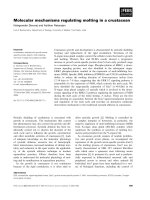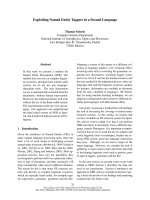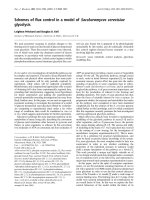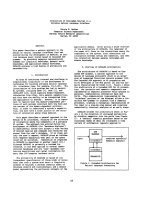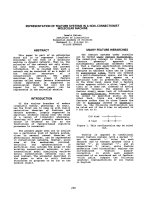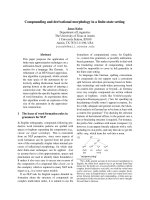Báo cáo khoa hoc:" Ecthyma gangrenosum without bacteremia in a previously healthy man: a case report" potx
Bạn đang xem bản rút gọn của tài liệu. Xem và tải ngay bản đầy đủ của tài liệu tại đây (670.49 KB, 3 trang )
BioMed Central
Page 1 of 3
(page number not for citation purposes)
Journal of Medical Case Reports
Open Access
Case report
Ecthyma gangrenosum without bacteremia in a previously healthy
man: a case report
Serap Gençer*
1
, Serdar Özer
1
, Aylin Ege Gül
2
, Mustafa Doğan
1
and
Öznur Ak
1
Address:
1
Department of Infectious Diseases and Clinical Microbiology, Kartal Dr. Lütfi Kırdar Training and Research Hospital, Istanbul, Turkey
and
2
Department of Pathology, Kartal Dr. Lütfi Kırdar Training and Research Hospital, Istanbul, Turkey
Email: Serap Gençer* - ; Serdar Özer - ; Aylin Ege Gül - ;
Mustafa Doğan - ; Öznur Ak -
* Corresponding author
Abstract
Introduction: Ecthyma gangrenosum is known as a characteristic lesion of Pseudomonas aeruginosa
sepsis and is usually seen in immunocompromised patients.
Case presentation: A previously healthy 63-year-old man was admitted with sloughy necrotic
ulcerations of the skin over his sternum. He was afebrile and in good condition. A skin biopsy
revealed ecthyma gangrenosum. Blood cultures remained sterile, but a culture of biopsy material
grew Pseudomonas aeruginosa.
Conclusion: Ecthyma gangrenosum may develop even in the absence of bacteremia and even in
immunocompetent patients. It should be considered as a possible diagnosis even when a previously
healthy patient has negative blood cultures.
Introduction
Ecthyma gangrenosum is a characteristic necrotic and bul-
lous skin lesion known to be caused by Pseudomonas aeru-
ginosa sepsis. It is usually seen in immunocompromised
people. However, it is rare to see ecthyma gangrenosum in
people with no evidence of bacteremia [1-6] and in those
who were previously healthy [7]. Herein, we report a rare
presentation of ecthyma gangrenosum in a previously
healthy adult male without bacteremia.
Case presentation
A previously healthy 63-year-old man was admitted with
a two week history of wounds over his sternum. Twenty
days before hospital admission, he had developed fever
and sore throat. Oral amoxicillin was given. Six days later
he noted an erythematous skin lesion over his sternum.
One week later his sore throat resolved but the skin lesion
worsened. He presented to a dermatologist and was diag-
nosed with erysipelas and received oral amoxicillin again.
Over the next two days, the skin lesion evolved to form
vesicles that were drained in the emergency department of
another hospital. The lesion progressed to ulceration over
the next five days.
The patient had no history of immunosuppressive disease
or treatment.
On admission he was afebrile (temperature of 37,2°C),
and hemodynamically stable. Physical examination
revealed two sloughy necrotic ulcerations of the skin over
Published: 22 January 2008
Journal of Medical Case Reports 2008, 2:14 doi:10.1186/1752-1947-2-14
Received: 20 August 2007
Accepted: 22 January 2008
This article is available from: />© 2008 Gençer et al; licensee BioMed Central Ltd.
This is an Open Access article distributed under the terms of the Creative Commons Attribution License ( />),
which permits unrestricted use, distribution, and reproduction in any medium, provided the original work is properly cited.
Journal of Medical Case Reports 2008, 2:14 />Page 2 of 3
(page number not for citation purposes)
the sternum with hyperemic margins. These lesions meas-
ured about 6 × 4 cm. and 2 × 1 cm. (Figure 1). The white
blood cell count was 12.700/mm
3
, the hemoglobin level
was 10.8 g/dL, and the platelet count was 561.000/mm
3
.
The erythrocyte sedimentation rate was 78 mm/hour, the
serum C-reactive protein level was 5,6 mg/L (range 0 – 5
mg/L). Liver function tests, blood urea nitrogen and
serum creatinine levels and chest radiographs were nor-
mal.
Blood cultures were taken. A skin biopsy with culture was
performed. While the results of cultures were pending,
antibiotic therapy with imipenem (500 mg. IV every 6
hours) was initiated. Pathological examination of the
biopsy material revealed ulcerated inflammatory cell infil-
tration, vascular proliferation and wide necrosis character-
istic of ecthyma gangrenosum (Figure 2). Blood cultures
remained sterile, but a culture of the biopsy material grew
Pseudomonas aeruginosa. Antibiotic treatment was contin-
ued for 14 days, after which the patient was admitted to
the Department of Plastic Surgery for skin grafting. Two
months later, the skin lesion had healed. One year later,
he remains healthy.
Discussion
It is well known that ecthyma gangrenosum is one of the
major dermatologic manifestations of severe, systemic
Pseudomonas aeruginosa infection. It occurs in only 1–6%
of patients with Pseudomonas bacteremia [8]. It had been
considered to be pathognomonic of Pseudomonas sepsis
until it was described in cases with infections caused by
group A Streptococcus, Aeromonas hydrophila, Staphylococ-
cus aureus, Serratia marcescens, Pseudomonas maltophilia,
Escherichia coli, Candida albicans, Aspergillus species and
Mucor species [9].
Ecthyma gangrenosum is usually seen in immunocom-
promised patients with leukemia, lymphoma, other
malignant diseases, severe burns or organ transplant, or in
people receiving immunosuppressive therapy [1,2,4,6].
However, it has been reported also in patients without
previously identified medical problems. Most of them
had a concurrent viral infection or had received recent
antibiotic therapy [7]. Ecthyma gangrenosum might be
the first manifestation of an underlying medical problem
and previously healthy patients should be followed
closely in the future [7,10].
The lesion begins as a painless red macule that enlarges
and becomes a slightly elevated papule. It evolves to a
hemorrhagic bulla that ruptures, forming a gangrenous
ulcer with a gray-black eschar surrounded by an erythema-
tous halo [1]. Classically, the pathogen is isolated from
the skin lesions as well as from the blood. These lesions
may occur anywhere, but are most usual on the anogenital
region, buttocks, extremities, abdomen, axillae and rarely
on the face [1,5].
Histologically, the lesions represent a necrotising vasculi-
tis caused by direct bacterial invasion of the media and
adventitia of the vascular walls, but not the intima [2]. In
general, acute mixed inflammatory cell infiltration and
vascular proliferation are seen in the dermis, often involv-
ing the subcutaneous tissue. Elastases produced by Pseu-
domonas destroy the elastic small vessels, leading to
hemorrhage and release of organisms into the surround-
ing tissue. Protease and endotoxin A elaborated by bacilli
are responsible for the direct tissue destruction and ulcer-
ative lesions. [5,9].
In classic bacteremic ecthyma gangrenosum, the lesion
represents a blood-borne metastatic seeding of Pseu-
domonas aeruginosa to the skin. However, there are a few
reports that ecthyma gangrenosum can represent localized
skin eruptions that are not accompanied by bacteremia or
systemic infection [1-6].
The source of infection in this patient cannot be deter-
mined with certainty, but it is possible that the patient
presented with erysipelas which subsequently became col-
onized and superinfected with hospital-acquired Pseu-
domonas aeruginosa while draining and then developed
into ecthyma gangrenosum. Negative blood cultures sug-
gest that ecthyma gangrenosum occurred as a primary
lesion at a site of prior skin trauma.
Early diagnosis and aggressive therapy are important in
the management of ecthyma gangrenosum. An antipseu-
Sloughy, necrotic ulceration of the skin characteristic of ecthyma gangrenosumFigure 1
Sloughy, necrotic ulceration of the skin characteristic of
ecthyma gangrenosum.
Publish with BioMed Central and every
scientist can read your work free of charge
"BioMed Central will be the most significant development for
disseminating the results of biomedical research in our lifetime."
Sir Paul Nurse, Cancer Research UK
Your research papers will be:
available free of charge to the entire biomedical community
peer reviewed and published immediately upon acceptance
cited in PubMed and archived on PubMed Central
yours — you keep the copyright
Submit your manuscript here:
/>BioMedcentral
Journal of Medical Case Reports 2008, 2:14 />Page 3 of 3
(page number not for citation purposes)
domonal beta-lactam antibiotic with or without an
aminoglycoside is appropriate for treatment of both bac-
teremic and nonbacteremic ecthyma gangrenosum [5].
The absence of bacteremia is associated with the best out-
come. Patients with Pseudomonas bacteremia have been
reported to have a mortality rate of 38% [7]. On the other
hand, only two patients (15%) died in a review of 13
patients with ecthyma gangrenosum without bacteremia
[1]. In another study, the mortality rate was 7.5 % in the
group of patients with skin lesions considered to be pri-
mary and 20 % in the group of patients with skin lesions
considered to be secondary to bacteremia [3].
Conclusion
As we point out in this case, ecthyma gangrenosum may
develop even in the absence of bacteremia and even in
immunocompetent people. It may be treated with appro-
priate antibiotics upon diagnosis by tissue culture and
microscopic examination. In conclusion, ecthyma gan-
grenosum should be considered as a possible diagnosis
even when a previously healthy patient has negative
blood cultures.
Competing interests
The author(s) declare that they have no competing inter-
ests.
Authors' contributions
SG participated in patient management, diagnosis,
reviewed the literature and drafted the manuscript. SÖ,
MD and ÖA participated in patient management and
diagnosis. AE made the pathological examination and
diagnosis. All authors read and approved the final manu-
script.
Consent
Written informed consent was obtained from the patient
for publication of this case report and any accompanying
images. A copy of the written consent is available for
review by the Editor-in-Chief of this journal.
References
Huminer D, Siegman-Igra Y, Morduchowicz G, Pitlik SD: Ecthyma
gangrenosum without bacteremia. Report of six cases and
review of the literature. Arch Intern Med 1987, 147:299-301.
2. Wolf JE, Liu HH, Rabinowitz LG: Ecthyma gangrenosum in the
absence of Pseudomonas bacteremia in a bone marrow
transplant recipient. Am J Med 1989, 87:595-597.
3. El Baze P, Thyss A, Vinti H, Deville A, Dellamonica P, Ortonne JP: A
study of nineteen immunocompromised patients with
extensive skin lesions caused by Pseudomonas aeruginosa
with and without bacteremia. Acta Derm Venereol 1991,
71:411-415.
4. Tornero C, Ricart C, Arnedo AL, Baeza R: Non-bacteremic
ecthyma gangrenosum in a patient with human immunode-
ficiency virus infection. Rev Clin Esp 1999, 199:332-333.
5. Song WK, Kim YC, Park HJ, Cinn YW: Ecthyma gangrenosum
without bacteraemia in leukaemic patient. Clin Exp Dermatol
2001, 26:395-397.
6. Singh N, Devi M, Devi S: Ecthyma gangrenosum: a rare cutane-
ous manifestation caused by Pseudomonas aeruginosa with-
out bacteremia in a leukemic patient. Indian J Dermatol Venereol
Leprol 2005, 71:128-129.
7. Bodey GP, Jadeja L, Elting L: Pseudomonas bacteremia: Retro-
spective analysis of 410 episodes. Arch Intern Med 1985,
145:1621-1629.
8. Fuchshuber PR, Lipman B, Kraybill WG, Gibbs JF: Ecthyma gan-
grenosum secondary to E. coli sepsis. Infect Med 1998,
15:798-801.
9. Martin-Ancel A, Borque C, del Castillo F: Pseudomonas sepsis in
children without previous medical problems. Pediatr Infect Dis
J 1993, 12:258-260.
10. Mull CC, Scarfone RJ, Conway D: Ecthyma gangrenosum as
amanifestation of Pseudomonas sepsis in a previously healthy
child. Ann Emerg Med 2000, 36:383-387.
Ulcerated inflamatory cell infiltration, vascular proliferation and wide necrosis characteristic of ecthyma gangrenosumFigure 2
Ulcerated inflamatory cell infiltration, vascular proliferation
and wide necrosis characteristic of ecthyma gangrenosum.
Publish with BioMed Central and every
scientist can read your work free of charge
"BioMed Central will be the most significant development for
disseminating the results of biomedical researc h in our lifetime."
Sir Paul Nurse, Cancer Research UK
Your research papers will be:
available free of charge to the entire biomedical community
peer reviewed and published immediately upon acceptance
cited in PubMed and archived on PubMed Central
yours — you keep the copyright
Submit your manuscript here:
/>BioMedcentral

